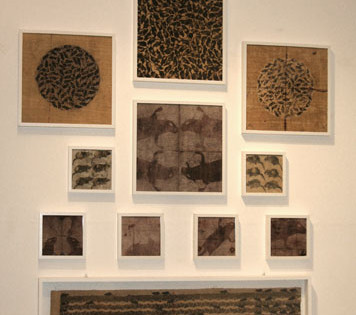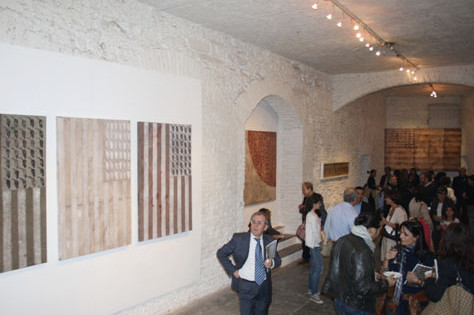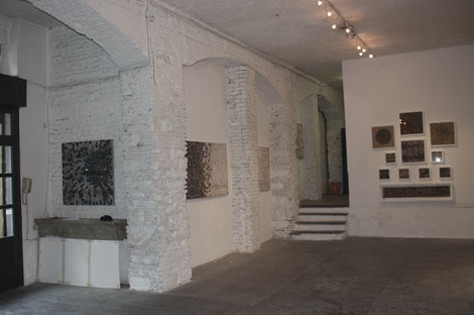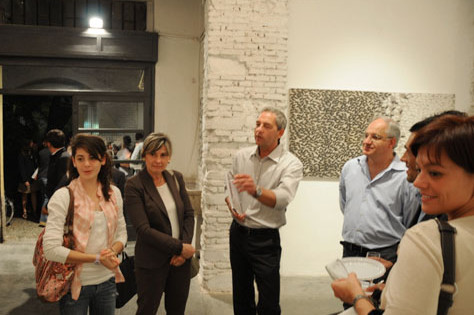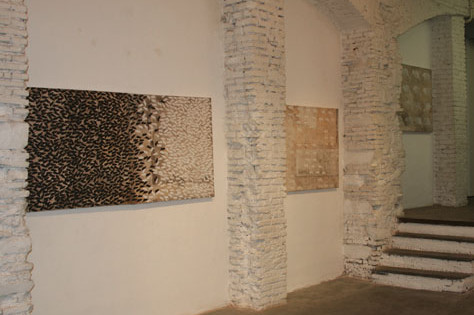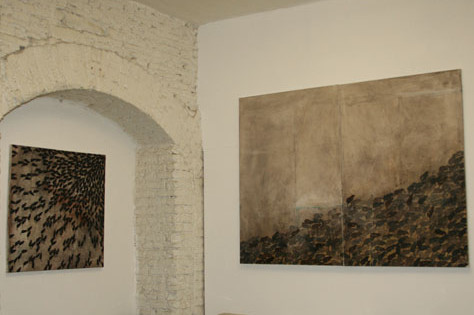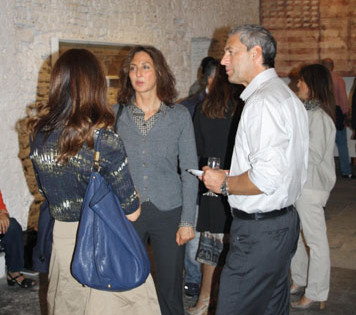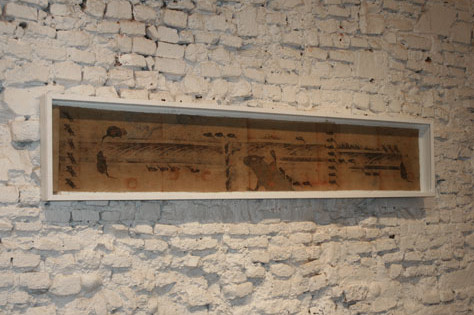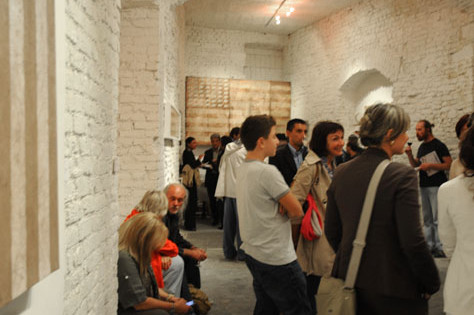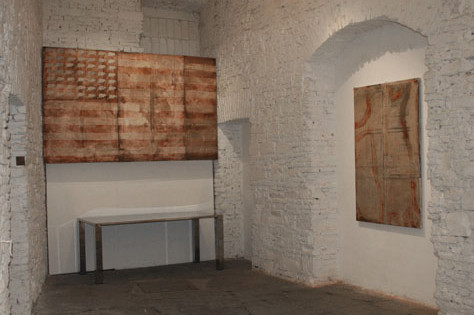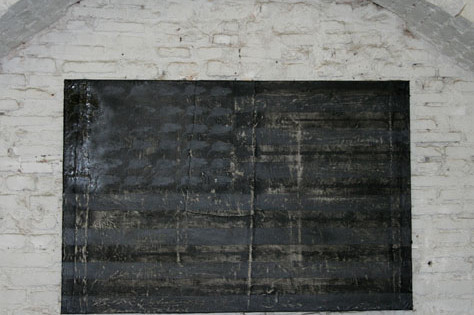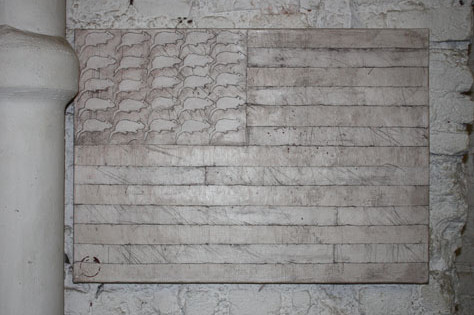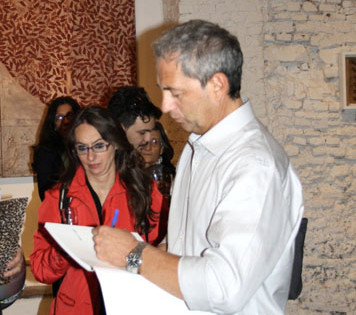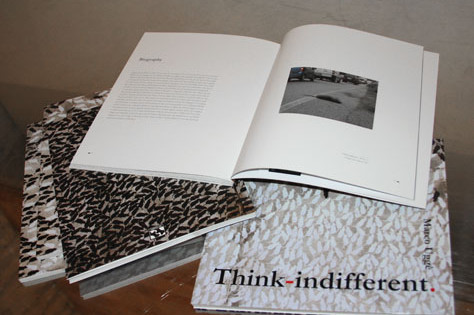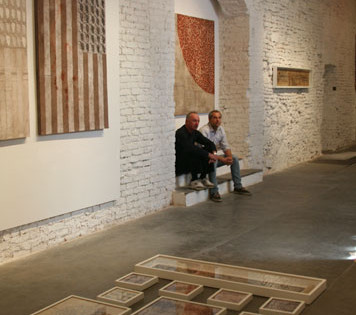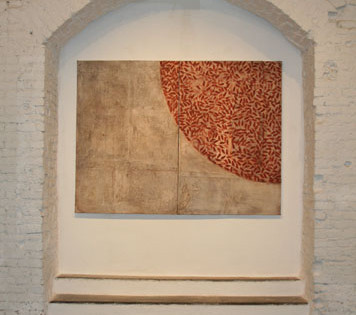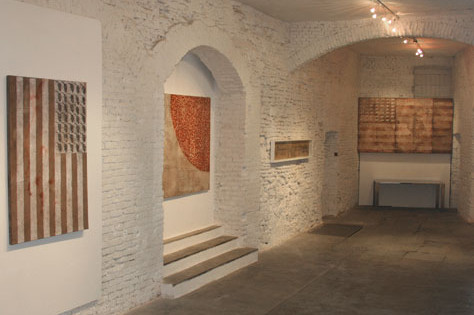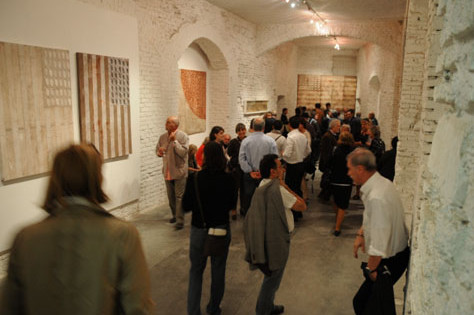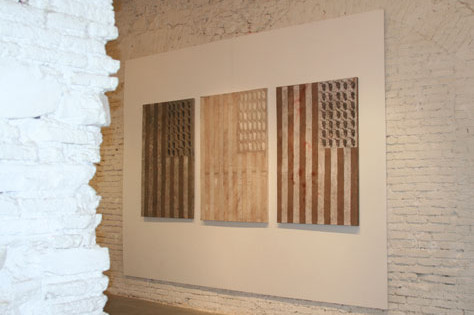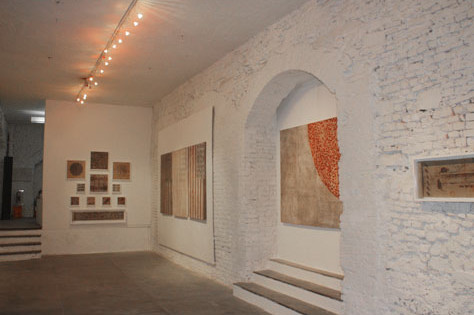MARCO UGGÈ Think-indifferent
The modern world is surrounded by a fence of indifference, one that is widening and extending
the boundaries of disinterest, detachment and non-commitment. Within indifference lurk
distraction and insensitivity: it separates us from the outside world; it is a conscious decision.
Never symbolic, indifference is at work in the running of day-to-day life, dwelling in cities
and the countryside at a time that is increasingly defined by subjective intentionality fuelled,
too often, by cynicism and designed to uphold the vested interests of individuals. It is the
domain of an exile from the world and its events; an exile from neighbours, nature and culture.
It is absenteeism from history. Homo inclusus has given his verdict. By isolating himself, he
begins to play out scripted relationships based on the reproduction of mechanical actions void
of any (genuine) shared emotions. He alienates himself, cuts himself off from all but one
perspective: his own. He nurtures the tempered existence of a spectator, a distracted passerby,
an emotional deserter, a fugitive, a narcissist and a nihilist. As he feeds this desert, he
relinquishes all interpersonal bonds: “The cult of self teaches that we should think only of
ourselves. The ‘cold’ behaviour this breeds is manifested through a calculated impediment; it
suppresses any somatic uprisings, a typical sign of human emotion”1 . Indifference does not
only appear alongside non-commitment, “but also in our inability to stray from rigid scripts that
are passed off for duty everywhere”2 . It is the tyranny of convention that leads the protagonist
of Camus’s novel, The Stranger, to feel estranged from himself and from the world and to
accept his imprisonment and punishment with complete indifference.
What Marco Uggè has set out to do is open a meaningful space that urges the present to make
immediate change. He is defending a project that promotes (new) normality, one that crosses
the territory of existence, of being, in different ways. His aim is to encourage dissent from a
feeling that reminds us to know our place, dissent from convention, imitation and immobility.
He does this so that we will get involved, interact with the world and stay in touch with our
feelings; he aims to prevent us going grey, falling into the void and becoming like Carla and
Michele in Moravia’s Times of Indifference, with their loss of critical action and their powerless
slide towards paralysis: two people destined for a world that combines omission and the nonchoice
to acquiesce (adaptation) with immobilism and inactivity (non-adaptation).
The painted white outline of the coypu on the road is an expression of this indifference; it is
not a symbol of loss (death), but one of coming, a fledgling awareness that convinces us to
accept our feelings and break with neutrality. It is a manifestation of malaise by those who reject
the shallowness and idleness of detachment, who do not recognise themselves in conformist
mimicry, and who are unable to distance themselves from circumstances. This condition is
embodied by the image of the coypu, which was exploited for its fur in the 1920s. These
mammals were released unchecked into the wild by bankrupt breeders, and today they are
denied the right to existence or to help because they are considered vermin and a hazard to
crops. As a result, they have become the victim of unmindful acts, including those of suburban
drivers. This indifference is highlighted not only by the number of tyre-streaked carcasses on the roads, but also by their repeated abuse: car after car, driver after driver. The coypu is returning
to the city and its streets, but this time not as a coat or a fur collar, but as a symbol, a banner. It is
the expression of an idea and an awareness that are part of a drive towards civic responsibility.
_________________________________________________________________________
Think-indifferent
Testo critico di Giovanni Pelloso
La contemporaneità ha aggiornato i paletti dell’indifferenza, amplificandone l’ampiezza
ed estendendo le zone del disinteresse, del distacco, del disimpegno. Nell’indifferenza c’è la
distrazione, c’è l’insensibilità a ogni distinzione, c’è la separazione da ciò che accade. C’è la
volontà. Mai astratta, essa si evidenzia nella pratica e nell’azione quotidiana. È un luogo del
sociale e di condivisione. Abita la metropoli come la campagna: un presente sempre più definito
da un’intenzionalità soggettiva animata da un sentimento cinico volto al sostegno e alla tutela
di interessi personali. È il dominio dell’esule. Dal mondo e dalle sue vicende. Dal prossimo.
Dalla natura e dalla cultura. È l’assenteismo dalla storia. È il pronunciarsi dell’homo inclusus.
Di colui che, escludendosi, aziona un copione relazionale regolato sulla riproduzione di atti
meccanici privi di una (reale) condivisione emotiva. Di colui che, estraniandosi, ripiegato su se
stesso, ancorato a un’unica prospettiva, la propria, coltiva la misurata esistenza dello spettatore,
del passante distratto, del disertore emotivo, dell’inerme, del fuggitivo, del narcisista, del
nichilista. Di colui che, riproducendo il deserto, si emancipa dai legami interpersonali: “Il culto
dell’io insegna a farsi i fatti propri. La condotta «fredda» che ne deriva si esprime attraverso
un calcolato impedimento: sopprime qualsiasi irruzione del somatico, tipica manifestazione
dell’essere emozionati”1 . L’indifferenza non coincide solamente con il disimpegno, “ma anche
nel non poter evadere dai copioni irrigiditi che dovunque vengono rappresentati per dovere”2 .
Quella tirannia delle convenzioni che condurrà il protagonista del romanzo di Camus, Lo
straniero, a sentirsi estraneo a se stesso e al mondo, ad accettare in totale indifferenza il carcere
e la condanna.
La sfida, per Marco Uggè, è nell’inaugurazione di uno spazio di senso che segnala al presente
l’urgenza di un cambiamento. A essere difeso è un progetto di (nuova) normalità realizzato con
un’azione che attraversa, in soluzioni diverse, il territorio dell’esistenza. Dell’essere. Per farsi
dissidente rispetto a quel sentire che invita a stare al proprio posto, al canone convenzionale,
all’imitazione, all’immobilità. Per lasciarsi coinvolgere. Per intrattenersi con il mondo. Per
rimanere in contatto con le proprie emozioni. Per non ingrigire. Per non frequentare il vuoto.
Per non corrispondere a Carla e Michele, i due de Gli indifferenti di Moravia. Alla loro perdita di
azione critica. Al loro lasciarsi condurre verso la paralisi. Impotenti. Destinati a una dimensione
che accoglie, al contempo, l’omissione e la non-scelta di opporsi (l’adattamento), l’immobilismo
e l’inattività (il non adattamento).
L’immagine della nutria, la cui sagoma di vernice bianca fotografata sull’asfalto ne è l’espressione,
si erge a simbolo non della perdita (morte), ma dell’avvento. Di una venuta consapevolezza
che è accettazione del proprio sentire, che è rottura della neutralità. Che è azione capace di
manifestare il disagio di chi non accetta la leggerezza e l’inoperosità del distacco, di chi non si
riconosce nel mimetismo conformista, di chi non riesce a distanziarsi dalle circostanze. Questa
condizione si risolve, dunque, nell’immagine della nutria: mammifero che, sfruttato dagli anni
Venti del secolo scorso per la sua pelliccia – è il famoso castorino –, oggi non ha diritto di
esistenza e di assistenza perché considerato infestante e dannoso per le colture a causa di un rilascio incontrollato nelle campagne da parte di allevatori in fallimento. Ciò ha concorso
a essere la vittima di un’azione superficiale da parte di chi, per esempio, percorre le vie del
traffico suburbano. Un’indifferenza resa ancor più evidente non solo dalla facilità di scoprire i
molti corpi schiacciati sull’asfalto, ma anche il loro ripetuto oltraggio. Auto dopo auto, autista
dopo autista. La nutria ritorna in città, nelle strade, questa volta non più indossata in forma di
cappotto o di morbido collo, ma divenendo emblema, vessillo. Espressione di un ideale, di una
consapevolezza, essa appartiene a un disegno di responsabilità civile.
-----------------------------------------------------------------
On the road
By Alessandro Beltrami
An obsession with surfaces. This has always been one of Marco Uggè’s characteristics: a surface that is not a screen of infinite and inscrutable worlds but a place in which things happen and leave resistant traces, in which they seek and often acquire a sense dimension. Great tables like slates that Uggè treats with wax, earth, dust, resin and even old printing inks and hydrocarbons to create surfaces that can then be assaulted, scratched, incised and corroded. Basic unorthodox technical processes to achieve a certain type of patina, worn out and laden with history. “Then in time / Great scratches were made on the mirror, / Letting the outside world come in, / And letting my inner self look out” reads Ernest Hyde’s gravestone in Spoon River Cemetery. Ending like this: “A mirror scratched reflects no image / And this is the silence of wisdom”.
For years Uggè’s work has been like a technical and intellectual apprenticeship. The autonomy of the surface that is attained in his paintings, in which the distinction between background and foreground is lost, was not an end but a condition. Without these introductory words, I do not believe one can appreciate the works in Think-indifferent to the full. The interchange between an interior richness and exterior stimuli activated by these scratched surfaces results in a concept in which the inner self, social awareness and environmental themes blend together. This might all have ended by being minced up into an indigestible and rhetorical compost heap. Uggè, on the contrary, sums it all up with a synthetic stroke of metaphor. All the elements we have mentioned are merged into the figure of the coypu. An animal that has been uprooted from its original habitat (it was originally imported from South America for its fur, which is the famous castorino for Italians, but when the market collapsed these rodents were liberated indiscriminately and spread throughout the countrysides of North and Central Italy). To general lack of interest, coypus are now the victims of daily massacres on the roads. In Uggè’s eyes, what may seem a marginal issue becomes an extraordinary emblem of the evil of indifference.
Uggè works out a coypu iconography. He subjects it to a stylisation process that makes it recognisable immediately. There is a twofold result: on one hand the shape of the living animal, on the other the outline, like that of a corpse at the scene of a murder, of the dead animal. If this solution has one aspect that brings it close to the language of metropolitan graffiti, the technical treatment combines processes that are typical of ancient art (with the assistance of the experience of the artist’s wife, Emilia, an established restorer), using non-European techniques such as batik. The aim of the sensorial factor, tactile and visual, is to overcome the depersonalising effect of indifference. The communication strategy is not to confront the observer with a proclamation head on, but an ironically clothed manifesto. The message has been inoculated.
Just as this rodent has “contaminated” the countryside, in the same way it can become the carrier of a positive virus with the capacity to waken consciences and civil society by suggesting that we should begin to think less indifferently. This is an obvious phase in the works of the Kaos series, seething with hundreds of shapes, sometimes suspended in a bubble as if they were in a cell on the point of explosion. In other cases, on the other hand, the animals reproduce in orderly, hypnotic ranks, in which, however, the destabilising element is never missing. The coypu’s viral nature also emerges in the Flag of Indifference. Here Uggè plays with another important element of contemporary imaginative processes. After Jasper Johns, the Stars and Stripes has become a topos of contemporary art, often in a pop art or an openly political key. Uggè, on the other hand, finds in it the archetype of all flags, the standard of standards. Those who walk towards a reawakening have a banner to march under. The coypus take the place of the stars. Sometimes they remain confined to their enclosure, at other times they scamper all over the flag. The stripes (white like the stripes painted on the asphalt on which their lives often come to an end) are a cage, a maze, a motorway of freedom. Uggè’s sensitivity to structure, processes and materials – colour mutations, marks sprayed over the surfaces, layers of fabric and seams like barbed wire – again transforms the surface into a scratched mirror.
Think-indifferent, then, looks as if it is a very serious game. Sometimes a very violent one too, as in the monotypes (a technique that he is very fond of), in which the coypu’s shape is outlined on a lumpy background like a mixture of tar and blood poured on to the surface. Red is the colour that comes up most frequently and is the element that leads us to a last, and perhaps the most surprising, interpretation. One according to which the coypu seems as if it were a kind of Christological animal. A daring concept, certainly. But without wishing to suggest comparisons that could sound offensive – even if this is certainly not our intention – Uggè’s coypus would seem to be wishing to join a crowded symbolic bestiary ranging from the lamb and the pelican to the lion, fish and peacock. It would not be correct to maintain that the coypu is used in these works as a direct symbol of Christ. The point we are trying to make is, rather, that Uggé makes use of objects whose symbolic and evocative functions are based on those proper to Jesus’s Passion. Starting from the shrouds made on big folded canvases with the imprints of the animals’ bodies and the shreds of coypu, relics of death in the true sense of the term, and therefore evidence of the existence of these animals created in situ with organic material, where the blood stains are collected like those on Veronica’s veil. These aspects are not unusual in contemporary art: one example consists of the rituals of Hermann Nitsch, in which, however, the orgiastic and neo-pagan element clashes with the Christian element. Uggè dwells on the para-religious element much less explicitly and adds a correct dose of irony, by means of which he manages to keep his distance from his model. And, paradoxically, this is exactly why he succeeds in taking the consequences to their logical conclusion. Not only does the coypu not appear to have any Good Samaritan prepared to take care of it, but its changing fortunes (from a luxury good to something unwanted) would seem to be similar to those of Christ, first borne in triumph and then abandoned and rejected. “He is despised and rejected of men, a man of sorrows, and acquainted with grief: and we hid as it were our faces from him; he was despised and we esteemed him not. Surely he hath borne our griefs, and carried our sorrows: yet we did esteem him stricken, smitten of God, and afflicted. But he was wounded for our transgressions, he was bruised for our iniquities: the chastisement of our peace was upon him and with his stripes we are healed.” This is the famous passage from the Old Testament in which the prophet Isaias foretells Christ’s Passion. Is it a sacrilege to compare the Passion with that great mutilated figure of a coypu that Uggé has hoisted up as if on a cross? And yet the process that Uggè starts and carries on through the animal’s “wounds” is precisely one of interior healing. Beyond the symbol and through the coypu’s “martyrdom”, the artist urges us to reclaim a possibility of salvation provided that we manage to see, and therefore take care of, our neighbour.
__________________________________________________________________________
Sulla strada
Testo critico di Alessandro Beltrami
L’ossessione per la superficie, è stata una delle caratteristiche di Marco Uggè: una superficie che
non è schermo di mondi infiniti e insondabili ma luogo dove le cose accadono, lasciano tracce
resistenti, cercano e spesso acquistano una dimensione di senso. Grandi tavole come lavagne,
trattate da Uggè con cere, terre, polveri, resine, persino vecchi inchiostri tipografici e idrocarburi
per creare superfici, appunto, che poi vengono aggredite, grattate, incise, corrose. Procedimenti
tecnici poco ortodossi basilari per arrivare a un determinato tipo di patina, consunta e carica
di storia. “Poi col tempo / grandi graffi si incisero sopra lo specchio / lasciando che il mondo
esterno vi entrasse, / e lasciando che vi affiorasse il mio io più segreto”, recita la lapide di
Hernest Hyde nel cimitero di Spoon River. E così conclude: “Uno specchio graffiato non
riflette immagini: / e questo è il silenzio della saggezza”.
Per anni il lavoro di Uggè è stato come un tirocinio, tecnico e intellettuale. L’autonomia della
superficie raggiunta nei suoi quadri, in cui si perde la distinzione tra fondo e primo piano, non
era un fine ma una condizione. Senza questa premessa non credo si possa cogliere a pieno
i lavori di Think-indifferent. L’interscambio, messo in moto da quelle superfici graffiate, tra
un’intima ricchezza e stimoli esterni è sfociato in un progetto in cui si mescolano sfera interiore,
attenzione sociale, temi ecologici. Tutto questo sarebbe potutto rimanere triturato in un
composto indigesto e retorica. Uggè invece lo risolve con un sintetico colpo di metafora. Ogni
elemento si riversa nella figura della nutria. Un animale sradicato dal suo contesto originario
(importato dal Sud America per la pelliccia, il celebre “castorino”, crollato il mercato è stato
liberato in modo indiscriminato, diffondendosi nelle campagne del Nord e del Centro Italia)
e che, nel disinteresse generale, è vittima di una strage quotidiana sulle strade. Quella che può
sembrare una vicenda marginale, agli occhi di Uggè si trasforma in uno straordinario emblema
del male dell’indifferenza.
Uggè elabora un’iconografia della nutria. La sottopone a un processo di stilizzazione che la renda immediatamente riconoscibile. L’esito è doppio: da una parte il profilo dell’animale vivo,
dall’altra la sagoma, come quella rilevata sulla scena del delitto. Se la soluzione ha un aspetto che
la avvicina al linguaggio dei graffiti metropolitani, il trattamento tecnico abbina procedimenti
tipici dell’arte antica (coadiuvato dall’esperienza della moglie Emilia, affermata restauratrice)
allo studio di quelli dell’arte extraeuropea, come il batik. L’aspetto sensoriale, tattile e visivo,
mira a superare l’effetto spersonalizzante dell’indifferenza. La strategia comunicativa non
prevede la frontalità di un vero e proprio proclama ma piuttosto un manifesto armato di ironia.
Il messaggio è inoculato.
Perché come il roditore ha “contaminato” la campagna, così può diventare portatore di un virus
positivo, capace, con il suo invito a pensare in modo meno indifferente, di risvegliare le coscienze
e la società civile. Un passaggio evidente nei lavori della serie Kaos, brulicanti di centinaia di
sagome, a volte sospese in una bolla come in una cellula pronta a esplodere. In altri casi invece
gli animali si riproducono in teorie ordinate e ipnotiche, in cui però non manca mai l’elemento
destabilizzante. La viralità della nutria emerge anche nelle Flag of indifference. Qui Uggè gioca con
un altro grande elemento dell’immaginario contemporaneo: la bandiera americana. Dopo Jasper
Johns il drappo a stelle e strisce è diventato un topos dell’arte contemporanea, spesso in chiave
pop o apertamente politica. Uggè vi individua invece l’archetipo di ogni bandiera, il vessillo
dei vessilli. Chi cammina verso il risveglio ha un segno sotto cui marciare. Le nutrie prendono
il posto delle stelle. A volte rimangono circoscritte nel loro recinto, in altre scorazzano per
tutta la bandiera. Le bande (bianche come quelle tracciate sull’asfalto su cui terminano spesso
le loro vite) sono una gabbia, un labirinto, un’autostrada di libertà. La sensibilità di Uggè per
la struttura, i processi e i materiali - dalle mutazioni di colori alle macchie che spruzzano la
superficie alle stratificazioni di tessuti fino alle cuciture come fili spinati - trasforma, ancora una
volta, la superficie in uno specchio graffiato.
Think-indifferent appare dunque come un gioco molto serio. A tratti anche violento, come nei
monotipi (tecnica a lui cara) in cui la sagoma della nutria è tracciata su un fondo grumoso come
un gettato di catrame e di sangue. Il rosso è il colore più ricorrente ed è l’elemento che porta
a un’ultima e forse più sorprendente chiave di lettura. Quella in cui la nutria appare come una
sorta di “animale cristologico”. Un azzardo, certo. Ma senza però voler qui avanzare paragoni
che potrebbero suonare - certo non lo sono nelle intenzioni - offensivi, la nutria sembra volersi
aggiungere a un folto bestiario simbolico che va dall’agnello al pellicano passando per il leone,
il pesce e il pavone. Sarebbe scorretto sostenere che la nutria sia qui impiegata come simbolo
diretto di Cristo. Ciò che si vuole sottolineare è piuttosto che Uggè mette in atto dispositivi il cui funzionamento simbolico ed evocativo si basa su quelli propri della Passione di Gesù. A
partire dalle sindoni realizzate su grandi teli ripiegati con le “impronte” del corpo dell’animale
fino agli strappi, vere e proprie reliquie della morte - e quindi testimoni dell’esistenza - della
nutria, realizzate direttamente in situ con il materiale organico, in cui l’ombra di sangue è raccolta
come il velo della Veronica. Si tratta di fatti non insoliti nell’arte contemporanea. Basti pensare
ad esempio ai rituali di Hermann Nitsch, in cui però l’elemento orgiastico e neopagano collide
con quello cristiano. Uggè spinge in modo assai meno esplicito sull’aspetto para-religioso e vi
aggiunge una giusta dose di ironia, attraverso la quale riesce a prendere le distanze dal modello.
E proprio per questo riesce, paradossalmente, a portarne fino in fondo le conseguenze. Non
solo la nutria ferita sembra non avere nessun Samaritano disposto a prendersi cura di lei. La sua
vicenda (da bene di lusso a indesiderabile) sembra ricalcare in minore quella di Cristo portato
in trionfo e poi abbandonato e reietto. “Come uno davanti al quale ci si copre la faccia, era
disprezzato e non ne avevamo alcuna stima. Eppure egli si è caricato delle nostre sofferenze,
si è addossato i nostri dolori e noi lo giudicavamo castigato, percosso da Dio e umiliato... Il
castigo che ci dà salvezza si è abbattuto su di lui; per le sue piaghe noi siamo stati guariti”. È
il celebre passo veterotestamentario in cui il profeta Isaia prefigura la Passione di Cristo. È un
sacrilegio accostarlo a quella grande sagoma monca di nutria che Uggè ha issato in verticale
come su una croce? Eppure quello colto e messo in moto da Uggè attraverso le “piaghe”
dell’animale è esattamente un percorso di guarigione interiore. Ci invita, oltre il simbolo e
attraverso il “martirio” della nutria, a riscoprire una possibilità di salvezza nella misura in cui
sapremo vedere, e per questo prenderci cura, del nostro prossimo.
the boundaries of disinterest, detachment and non-commitment. Within indifference lurk
distraction and insensitivity: it separates us from the outside world; it is a conscious decision.
Never symbolic, indifference is at work in the running of day-to-day life, dwelling in cities
and the countryside at a time that is increasingly defined by subjective intentionality fuelled,
too often, by cynicism and designed to uphold the vested interests of individuals. It is the
domain of an exile from the world and its events; an exile from neighbours, nature and culture.
It is absenteeism from history. Homo inclusus has given his verdict. By isolating himself, he
begins to play out scripted relationships based on the reproduction of mechanical actions void
of any (genuine) shared emotions. He alienates himself, cuts himself off from all but one
perspective: his own. He nurtures the tempered existence of a spectator, a distracted passerby,
an emotional deserter, a fugitive, a narcissist and a nihilist. As he feeds this desert, he
relinquishes all interpersonal bonds: “The cult of self teaches that we should think only of
ourselves. The ‘cold’ behaviour this breeds is manifested through a calculated impediment; it
suppresses any somatic uprisings, a typical sign of human emotion”1 . Indifference does not
only appear alongside non-commitment, “but also in our inability to stray from rigid scripts that
are passed off for duty everywhere”2 . It is the tyranny of convention that leads the protagonist
of Camus’s novel, The Stranger, to feel estranged from himself and from the world and to
accept his imprisonment and punishment with complete indifference.
What Marco Uggè has set out to do is open a meaningful space that urges the present to make
immediate change. He is defending a project that promotes (new) normality, one that crosses
the territory of existence, of being, in different ways. His aim is to encourage dissent from a
feeling that reminds us to know our place, dissent from convention, imitation and immobility.
He does this so that we will get involved, interact with the world and stay in touch with our
feelings; he aims to prevent us going grey, falling into the void and becoming like Carla and
Michele in Moravia’s Times of Indifference, with their loss of critical action and their powerless
slide towards paralysis: two people destined for a world that combines omission and the nonchoice
to acquiesce (adaptation) with immobilism and inactivity (non-adaptation).
The painted white outline of the coypu on the road is an expression of this indifference; it is
not a symbol of loss (death), but one of coming, a fledgling awareness that convinces us to
accept our feelings and break with neutrality. It is a manifestation of malaise by those who reject
the shallowness and idleness of detachment, who do not recognise themselves in conformist
mimicry, and who are unable to distance themselves from circumstances. This condition is
embodied by the image of the coypu, which was exploited for its fur in the 1920s. These
mammals were released unchecked into the wild by bankrupt breeders, and today they are
denied the right to existence or to help because they are considered vermin and a hazard to
crops. As a result, they have become the victim of unmindful acts, including those of suburban
drivers. This indifference is highlighted not only by the number of tyre-streaked carcasses on the roads, but also by their repeated abuse: car after car, driver after driver. The coypu is returning
to the city and its streets, but this time not as a coat or a fur collar, but as a symbol, a banner. It is
the expression of an idea and an awareness that are part of a drive towards civic responsibility.
_________________________________________________________________________
Think-indifferent
Testo critico di Giovanni Pelloso
La contemporaneità ha aggiornato i paletti dell’indifferenza, amplificandone l’ampiezza
ed estendendo le zone del disinteresse, del distacco, del disimpegno. Nell’indifferenza c’è la
distrazione, c’è l’insensibilità a ogni distinzione, c’è la separazione da ciò che accade. C’è la
volontà. Mai astratta, essa si evidenzia nella pratica e nell’azione quotidiana. È un luogo del
sociale e di condivisione. Abita la metropoli come la campagna: un presente sempre più definito
da un’intenzionalità soggettiva animata da un sentimento cinico volto al sostegno e alla tutela
di interessi personali. È il dominio dell’esule. Dal mondo e dalle sue vicende. Dal prossimo.
Dalla natura e dalla cultura. È l’assenteismo dalla storia. È il pronunciarsi dell’homo inclusus.
Di colui che, escludendosi, aziona un copione relazionale regolato sulla riproduzione di atti
meccanici privi di una (reale) condivisione emotiva. Di colui che, estraniandosi, ripiegato su se
stesso, ancorato a un’unica prospettiva, la propria, coltiva la misurata esistenza dello spettatore,
del passante distratto, del disertore emotivo, dell’inerme, del fuggitivo, del narcisista, del
nichilista. Di colui che, riproducendo il deserto, si emancipa dai legami interpersonali: “Il culto
dell’io insegna a farsi i fatti propri. La condotta «fredda» che ne deriva si esprime attraverso
un calcolato impedimento: sopprime qualsiasi irruzione del somatico, tipica manifestazione
dell’essere emozionati”1 . L’indifferenza non coincide solamente con il disimpegno, “ma anche
nel non poter evadere dai copioni irrigiditi che dovunque vengono rappresentati per dovere”2 .
Quella tirannia delle convenzioni che condurrà il protagonista del romanzo di Camus, Lo
straniero, a sentirsi estraneo a se stesso e al mondo, ad accettare in totale indifferenza il carcere
e la condanna.
La sfida, per Marco Uggè, è nell’inaugurazione di uno spazio di senso che segnala al presente
l’urgenza di un cambiamento. A essere difeso è un progetto di (nuova) normalità realizzato con
un’azione che attraversa, in soluzioni diverse, il territorio dell’esistenza. Dell’essere. Per farsi
dissidente rispetto a quel sentire che invita a stare al proprio posto, al canone convenzionale,
all’imitazione, all’immobilità. Per lasciarsi coinvolgere. Per intrattenersi con il mondo. Per
rimanere in contatto con le proprie emozioni. Per non ingrigire. Per non frequentare il vuoto.
Per non corrispondere a Carla e Michele, i due de Gli indifferenti di Moravia. Alla loro perdita di
azione critica. Al loro lasciarsi condurre verso la paralisi. Impotenti. Destinati a una dimensione
che accoglie, al contempo, l’omissione e la non-scelta di opporsi (l’adattamento), l’immobilismo
e l’inattività (il non adattamento).
L’immagine della nutria, la cui sagoma di vernice bianca fotografata sull’asfalto ne è l’espressione,
si erge a simbolo non della perdita (morte), ma dell’avvento. Di una venuta consapevolezza
che è accettazione del proprio sentire, che è rottura della neutralità. Che è azione capace di
manifestare il disagio di chi non accetta la leggerezza e l’inoperosità del distacco, di chi non si
riconosce nel mimetismo conformista, di chi non riesce a distanziarsi dalle circostanze. Questa
condizione si risolve, dunque, nell’immagine della nutria: mammifero che, sfruttato dagli anni
Venti del secolo scorso per la sua pelliccia – è il famoso castorino –, oggi non ha diritto di
esistenza e di assistenza perché considerato infestante e dannoso per le colture a causa di un rilascio incontrollato nelle campagne da parte di allevatori in fallimento. Ciò ha concorso
a essere la vittima di un’azione superficiale da parte di chi, per esempio, percorre le vie del
traffico suburbano. Un’indifferenza resa ancor più evidente non solo dalla facilità di scoprire i
molti corpi schiacciati sull’asfalto, ma anche il loro ripetuto oltraggio. Auto dopo auto, autista
dopo autista. La nutria ritorna in città, nelle strade, questa volta non più indossata in forma di
cappotto o di morbido collo, ma divenendo emblema, vessillo. Espressione di un ideale, di una
consapevolezza, essa appartiene a un disegno di responsabilità civile.
-----------------------------------------------------------------
On the road
By Alessandro Beltrami
An obsession with surfaces. This has always been one of Marco Uggè’s characteristics: a surface that is not a screen of infinite and inscrutable worlds but a place in which things happen and leave resistant traces, in which they seek and often acquire a sense dimension. Great tables like slates that Uggè treats with wax, earth, dust, resin and even old printing inks and hydrocarbons to create surfaces that can then be assaulted, scratched, incised and corroded. Basic unorthodox technical processes to achieve a certain type of patina, worn out and laden with history. “Then in time / Great scratches were made on the mirror, / Letting the outside world come in, / And letting my inner self look out” reads Ernest Hyde’s gravestone in Spoon River Cemetery. Ending like this: “A mirror scratched reflects no image / And this is the silence of wisdom”.
For years Uggè’s work has been like a technical and intellectual apprenticeship. The autonomy of the surface that is attained in his paintings, in which the distinction between background and foreground is lost, was not an end but a condition. Without these introductory words, I do not believe one can appreciate the works in Think-indifferent to the full. The interchange between an interior richness and exterior stimuli activated by these scratched surfaces results in a concept in which the inner self, social awareness and environmental themes blend together. This might all have ended by being minced up into an indigestible and rhetorical compost heap. Uggè, on the contrary, sums it all up with a synthetic stroke of metaphor. All the elements we have mentioned are merged into the figure of the coypu. An animal that has been uprooted from its original habitat (it was originally imported from South America for its fur, which is the famous castorino for Italians, but when the market collapsed these rodents were liberated indiscriminately and spread throughout the countrysides of North and Central Italy). To general lack of interest, coypus are now the victims of daily massacres on the roads. In Uggè’s eyes, what may seem a marginal issue becomes an extraordinary emblem of the evil of indifference.
Uggè works out a coypu iconography. He subjects it to a stylisation process that makes it recognisable immediately. There is a twofold result: on one hand the shape of the living animal, on the other the outline, like that of a corpse at the scene of a murder, of the dead animal. If this solution has one aspect that brings it close to the language of metropolitan graffiti, the technical treatment combines processes that are typical of ancient art (with the assistance of the experience of the artist’s wife, Emilia, an established restorer), using non-European techniques such as batik. The aim of the sensorial factor, tactile and visual, is to overcome the depersonalising effect of indifference. The communication strategy is not to confront the observer with a proclamation head on, but an ironically clothed manifesto. The message has been inoculated.
Just as this rodent has “contaminated” the countryside, in the same way it can become the carrier of a positive virus with the capacity to waken consciences and civil society by suggesting that we should begin to think less indifferently. This is an obvious phase in the works of the Kaos series, seething with hundreds of shapes, sometimes suspended in a bubble as if they were in a cell on the point of explosion. In other cases, on the other hand, the animals reproduce in orderly, hypnotic ranks, in which, however, the destabilising element is never missing. The coypu’s viral nature also emerges in the Flag of Indifference. Here Uggè plays with another important element of contemporary imaginative processes. After Jasper Johns, the Stars and Stripes has become a topos of contemporary art, often in a pop art or an openly political key. Uggè, on the other hand, finds in it the archetype of all flags, the standard of standards. Those who walk towards a reawakening have a banner to march under. The coypus take the place of the stars. Sometimes they remain confined to their enclosure, at other times they scamper all over the flag. The stripes (white like the stripes painted on the asphalt on which their lives often come to an end) are a cage, a maze, a motorway of freedom. Uggè’s sensitivity to structure, processes and materials – colour mutations, marks sprayed over the surfaces, layers of fabric and seams like barbed wire – again transforms the surface into a scratched mirror.
Think-indifferent, then, looks as if it is a very serious game. Sometimes a very violent one too, as in the monotypes (a technique that he is very fond of), in which the coypu’s shape is outlined on a lumpy background like a mixture of tar and blood poured on to the surface. Red is the colour that comes up most frequently and is the element that leads us to a last, and perhaps the most surprising, interpretation. One according to which the coypu seems as if it were a kind of Christological animal. A daring concept, certainly. But without wishing to suggest comparisons that could sound offensive – even if this is certainly not our intention – Uggè’s coypus would seem to be wishing to join a crowded symbolic bestiary ranging from the lamb and the pelican to the lion, fish and peacock. It would not be correct to maintain that the coypu is used in these works as a direct symbol of Christ. The point we are trying to make is, rather, that Uggé makes use of objects whose symbolic and evocative functions are based on those proper to Jesus’s Passion. Starting from the shrouds made on big folded canvases with the imprints of the animals’ bodies and the shreds of coypu, relics of death in the true sense of the term, and therefore evidence of the existence of these animals created in situ with organic material, where the blood stains are collected like those on Veronica’s veil. These aspects are not unusual in contemporary art: one example consists of the rituals of Hermann Nitsch, in which, however, the orgiastic and neo-pagan element clashes with the Christian element. Uggè dwells on the para-religious element much less explicitly and adds a correct dose of irony, by means of which he manages to keep his distance from his model. And, paradoxically, this is exactly why he succeeds in taking the consequences to their logical conclusion. Not only does the coypu not appear to have any Good Samaritan prepared to take care of it, but its changing fortunes (from a luxury good to something unwanted) would seem to be similar to those of Christ, first borne in triumph and then abandoned and rejected. “He is despised and rejected of men, a man of sorrows, and acquainted with grief: and we hid as it were our faces from him; he was despised and we esteemed him not. Surely he hath borne our griefs, and carried our sorrows: yet we did esteem him stricken, smitten of God, and afflicted. But he was wounded for our transgressions, he was bruised for our iniquities: the chastisement of our peace was upon him and with his stripes we are healed.” This is the famous passage from the Old Testament in which the prophet Isaias foretells Christ’s Passion. Is it a sacrilege to compare the Passion with that great mutilated figure of a coypu that Uggé has hoisted up as if on a cross? And yet the process that Uggè starts and carries on through the animal’s “wounds” is precisely one of interior healing. Beyond the symbol and through the coypu’s “martyrdom”, the artist urges us to reclaim a possibility of salvation provided that we manage to see, and therefore take care of, our neighbour.
__________________________________________________________________________
Sulla strada
Testo critico di Alessandro Beltrami
L’ossessione per la superficie, è stata una delle caratteristiche di Marco Uggè: una superficie che
non è schermo di mondi infiniti e insondabili ma luogo dove le cose accadono, lasciano tracce
resistenti, cercano e spesso acquistano una dimensione di senso. Grandi tavole come lavagne,
trattate da Uggè con cere, terre, polveri, resine, persino vecchi inchiostri tipografici e idrocarburi
per creare superfici, appunto, che poi vengono aggredite, grattate, incise, corrose. Procedimenti
tecnici poco ortodossi basilari per arrivare a un determinato tipo di patina, consunta e carica
di storia. “Poi col tempo / grandi graffi si incisero sopra lo specchio / lasciando che il mondo
esterno vi entrasse, / e lasciando che vi affiorasse il mio io più segreto”, recita la lapide di
Hernest Hyde nel cimitero di Spoon River. E così conclude: “Uno specchio graffiato non
riflette immagini: / e questo è il silenzio della saggezza”.
Per anni il lavoro di Uggè è stato come un tirocinio, tecnico e intellettuale. L’autonomia della
superficie raggiunta nei suoi quadri, in cui si perde la distinzione tra fondo e primo piano, non
era un fine ma una condizione. Senza questa premessa non credo si possa cogliere a pieno
i lavori di Think-indifferent. L’interscambio, messo in moto da quelle superfici graffiate, tra
un’intima ricchezza e stimoli esterni è sfociato in un progetto in cui si mescolano sfera interiore,
attenzione sociale, temi ecologici. Tutto questo sarebbe potutto rimanere triturato in un
composto indigesto e retorica. Uggè invece lo risolve con un sintetico colpo di metafora. Ogni
elemento si riversa nella figura della nutria. Un animale sradicato dal suo contesto originario
(importato dal Sud America per la pelliccia, il celebre “castorino”, crollato il mercato è stato
liberato in modo indiscriminato, diffondendosi nelle campagne del Nord e del Centro Italia)
e che, nel disinteresse generale, è vittima di una strage quotidiana sulle strade. Quella che può
sembrare una vicenda marginale, agli occhi di Uggè si trasforma in uno straordinario emblema
del male dell’indifferenza.
Uggè elabora un’iconografia della nutria. La sottopone a un processo di stilizzazione che la renda immediatamente riconoscibile. L’esito è doppio: da una parte il profilo dell’animale vivo,
dall’altra la sagoma, come quella rilevata sulla scena del delitto. Se la soluzione ha un aspetto che
la avvicina al linguaggio dei graffiti metropolitani, il trattamento tecnico abbina procedimenti
tipici dell’arte antica (coadiuvato dall’esperienza della moglie Emilia, affermata restauratrice)
allo studio di quelli dell’arte extraeuropea, come il batik. L’aspetto sensoriale, tattile e visivo,
mira a superare l’effetto spersonalizzante dell’indifferenza. La strategia comunicativa non
prevede la frontalità di un vero e proprio proclama ma piuttosto un manifesto armato di ironia.
Il messaggio è inoculato.
Perché come il roditore ha “contaminato” la campagna, così può diventare portatore di un virus
positivo, capace, con il suo invito a pensare in modo meno indifferente, di risvegliare le coscienze
e la società civile. Un passaggio evidente nei lavori della serie Kaos, brulicanti di centinaia di
sagome, a volte sospese in una bolla come in una cellula pronta a esplodere. In altri casi invece
gli animali si riproducono in teorie ordinate e ipnotiche, in cui però non manca mai l’elemento
destabilizzante. La viralità della nutria emerge anche nelle Flag of indifference. Qui Uggè gioca con
un altro grande elemento dell’immaginario contemporaneo: la bandiera americana. Dopo Jasper
Johns il drappo a stelle e strisce è diventato un topos dell’arte contemporanea, spesso in chiave
pop o apertamente politica. Uggè vi individua invece l’archetipo di ogni bandiera, il vessillo
dei vessilli. Chi cammina verso il risveglio ha un segno sotto cui marciare. Le nutrie prendono
il posto delle stelle. A volte rimangono circoscritte nel loro recinto, in altre scorazzano per
tutta la bandiera. Le bande (bianche come quelle tracciate sull’asfalto su cui terminano spesso
le loro vite) sono una gabbia, un labirinto, un’autostrada di libertà. La sensibilità di Uggè per
la struttura, i processi e i materiali - dalle mutazioni di colori alle macchie che spruzzano la
superficie alle stratificazioni di tessuti fino alle cuciture come fili spinati - trasforma, ancora una
volta, la superficie in uno specchio graffiato.
Think-indifferent appare dunque come un gioco molto serio. A tratti anche violento, come nei
monotipi (tecnica a lui cara) in cui la sagoma della nutria è tracciata su un fondo grumoso come
un gettato di catrame e di sangue. Il rosso è il colore più ricorrente ed è l’elemento che porta
a un’ultima e forse più sorprendente chiave di lettura. Quella in cui la nutria appare come una
sorta di “animale cristologico”. Un azzardo, certo. Ma senza però voler qui avanzare paragoni
che potrebbero suonare - certo non lo sono nelle intenzioni - offensivi, la nutria sembra volersi
aggiungere a un folto bestiario simbolico che va dall’agnello al pellicano passando per il leone,
il pesce e il pavone. Sarebbe scorretto sostenere che la nutria sia qui impiegata come simbolo
diretto di Cristo. Ciò che si vuole sottolineare è piuttosto che Uggè mette in atto dispositivi il cui funzionamento simbolico ed evocativo si basa su quelli propri della Passione di Gesù. A
partire dalle sindoni realizzate su grandi teli ripiegati con le “impronte” del corpo dell’animale
fino agli strappi, vere e proprie reliquie della morte - e quindi testimoni dell’esistenza - della
nutria, realizzate direttamente in situ con il materiale organico, in cui l’ombra di sangue è raccolta
come il velo della Veronica. Si tratta di fatti non insoliti nell’arte contemporanea. Basti pensare
ad esempio ai rituali di Hermann Nitsch, in cui però l’elemento orgiastico e neopagano collide
con quello cristiano. Uggè spinge in modo assai meno esplicito sull’aspetto para-religioso e vi
aggiunge una giusta dose di ironia, attraverso la quale riesce a prendere le distanze dal modello.
E proprio per questo riesce, paradossalmente, a portarne fino in fondo le conseguenze. Non
solo la nutria ferita sembra non avere nessun Samaritano disposto a prendersi cura di lei. La sua
vicenda (da bene di lusso a indesiderabile) sembra ricalcare in minore quella di Cristo portato
in trionfo e poi abbandonato e reietto. “Come uno davanti al quale ci si copre la faccia, era
disprezzato e non ne avevamo alcuna stima. Eppure egli si è caricato delle nostre sofferenze,
si è addossato i nostri dolori e noi lo giudicavamo castigato, percosso da Dio e umiliato... Il
castigo che ci dà salvezza si è abbattuto su di lui; per le sue piaghe noi siamo stati guariti”. È
il celebre passo veterotestamentario in cui il profeta Isaia prefigura la Passione di Cristo. È un
sacrilegio accostarlo a quella grande sagoma monca di nutria che Uggè ha issato in verticale
come su una croce? Eppure quello colto e messo in moto da Uggè attraverso le “piaghe”
dell’animale è esattamente un percorso di guarigione interiore. Ci invita, oltre il simbolo e
attraverso il “martirio” della nutria, a riscoprire una possibilità di salvezza nella misura in cui
sapremo vedere, e per questo prenderci cura, del nostro prossimo.

